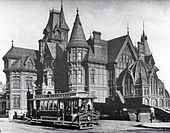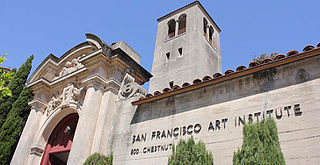
San Francisco Art Institute (SFAI) was a private college of contemporary art in San Francisco, California. Founded in 1871, SFAI was one of the oldest art schools in the United States and the oldest west of the Mississippi River. Approximately 220 undergraduates and 112 graduate students were enrolled in 2021. The institution was accredited by the Western Association of Schools and Colleges (WASC) and the National Association of Schools of Art and Design (NASAD), and was a member of the Association of Independent Colleges of Art and Design (AICAD). The school closed permanently in July 2022.
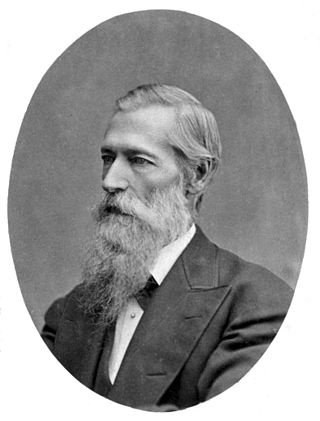
Mark Hopkins Jr. was an American railroad executive. He was one of four principal investors that funded Theodore D. Judah's idea of building a railway over the Sierra Nevada from Sacramento, California to Promontory, Utah. They formed the Central Pacific Railroad along with Leland Stanford, Charles Crocker, and Collis Huntington in 1861.
InterContinental Hotels Group (IHG), marketed as IHG Hotels & Resorts, is a British multinational hospitality company headquartered in Windsor, England. It is listed on the London Stock Exchange and the New York Stock Exchange. It is also a constituent of the FTSE 100 Index.

Ralston Hall Mansion located in Belmont, California, was the country house of William Chapman Ralston, a San Francisco businessman, a founder of the Bank of California, and a financier of the Comstock Lode. It is an opulent Italianate Villa, modified with touches of Steamboat Gothic and Victorian details. It is a California Historical Landmark and is designated a National Historic Landmark. It is now part of Notre Dame de Namur University.

The Top of the Mark is a penthouse level bar located on the nineteenth floor of the Mark Hopkins Hotel on Nob Hill at California and Mason Streets in San Francisco, California. Located at the highest point of downtown San Francisco, on fog-free days the Top of the Mark has views of the financial district, Chinatown, North Beach, The San Francisco Bay, and of Grace Cathedral and Huntington Park.

This is intended to be a complete list of the properties and districts on the National Register of Historic Places in San Francisco, California, United States. Latitude and longitude coordinates are provided for many National Register properties and districts; these locations may be seen together in an online map.

The Palace Hotel is a landmark historic hotel in San Francisco, California, located at the southwest corner of Market and New Montgomery streets. The hotel is also referred to as the "new" Palace Hotel to distinguish it from the original 1875 Palace Hotel, which had been demolished after being gutted by the fire caused by the 1906 San Francisco earthquake.

Regent Hotels & Resorts is a British luxury hospitality brand, founded by hotelier Robert H. Burns in 1970. After passing through different owners since foundation, it is currently jointly owned by IHG Hotels & Resorts and Formosa International Hotels Corporation since July 2018, with hotels and resorts in Asia and Europe.

The InterContinental San Francisco is a high-rise hotel at 888 Howard Street in the South of Market district of San Francisco, California. The 103.63 m (340 ft) 32-story hotel has 550 hotel rooms, and is operated by the InterContinental Hotels Group. The hotel is next to the Moscone West Center, completed in 2003. The hotel opened on February 28, 2008. There is a two-level underground garage and a six-floor podium housing hotel amenities.
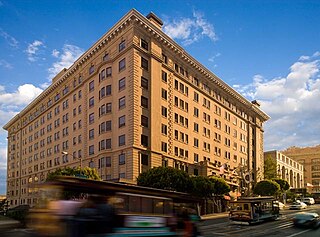
The Stanford Court Hotel is a historic 393-room hotel located at 905 California Street on Nob Hill in San Francisco, California. The hotel sits at the intersection of California & Powell St, where the city's cable car lines also intersect.

The Fairmont San Francisco is a luxury hotel at 950 Mason Street, atop Nob Hill in San Francisco, California. The hotel was named after mining magnate and U.S. Senator James Graham Fair (1831–94), by his daughters, Theresa Fair Oelrichs and Virginia Fair Vanderbilt, who built the hotel in his honor. The hotel was the vanguard of the Fairmont Hotels and Resorts chain. The group is now owned by Fairmont Raffles Hotels International, but all the original Fairmont hotels still keep their names.

California Street is a major thoroughfare in San Francisco, California. It is one of the longest streets in San Francisco, and includes a number of important landmarks. It runs in an approximately straight 5.2 mi (8.4 km) east-west line from the Financial District to Lincoln Park in the far Northwest corner of the City.
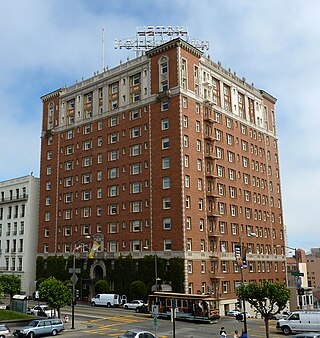
The Huntington Hotel is a historic luxury hotel at the top of the Nob Hill district of San Francisco, California. It is located at 1075 California Street, corner of Taylor Street. The hotel is a twelve-story, Georgian-style brick building that features 135 guest rooms and suites. It is currently closed.
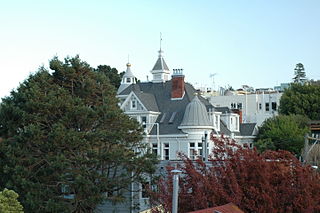
The Alfred E. Clarke Mansion, also known as the Caselli Mansion, Nobby Clarke's Castle and Nobby Clarke's Folly, is a mansion at 250 Douglass Street on the corner of Caselli Avenue in Eureka Valley, San Francisco, California. Built in 1891 by Alfred "Nobby" Clarke, it has been a hospital and is now an apartment building. It became a San Francisco Designated Landmark in 1975.

The James C. Flood Mansion is a historic mansion at 1000 California Street, atop Nob Hill in San Francisco, California, USA. Now home of the Pacific-Union Club, it was built in 1886 as the townhouse for James C. Flood, a 19th-century silver baron. It was the first brownstone building west of the Mississippi River, and the only mansion on Nob Hill to structurally survive the 1906 San Francisco earthquake and fire. It was declared a National Historic Landmark in 1966.

Weeks and Day was an American architectural firm founded in 1916 by architect Charles Peter Weeks (1870–1928) and engineer William Peyton Day (1886–1966).

The InterContinental New York Barclay Hotel is a hotel at 111 East 48th Street, on Lexington Avenue between 48th and 49th Streets, in the Midtown Manhattan neighborhood of New York City. The 14-story hotel, operated by IHG Hotels & Resorts, was designed by Cross and Cross in the Colonial style and contains 702 rooms. The Barclay was one of several large hotels developed around Grand Central Terminal as part of Terminal City.

Henry William Cleaveland was an American architect based in New York, New York, and then San Francisco, California, and Portland, Oregon. He was one of the founding members of the American Institute of Architects, and several of his works have been listed on the National Register of Historic Places. His works include Ralston Hall, a National Historic Landmark in the San Francisco Bay Area, the original Palace Hotel in San Francisco, and the Bidwell Mansion in Chico, California.

Nob Hill is a neighborhood of San Francisco, California, United States that is known for its numerous luxury hotels and historic mansions. Nob Hill has historically served as a center of San Francisco's upper class. Nob Hill is among the highest-income neighborhoods in the United States, as well as one of the most desirable and expensive real estate markets in the country.
The John Hopkins Spring Estate is a large estate in Berkeley, California. The associated Spring Mansion was built in the 1910s by East Bay developer John Hopkins Spring and designed by architect John Hudson Thomas. It later became the site of a school founded by educator Cora Lenore Williams. It has been a City of Berkeley Landmark since 2000.




